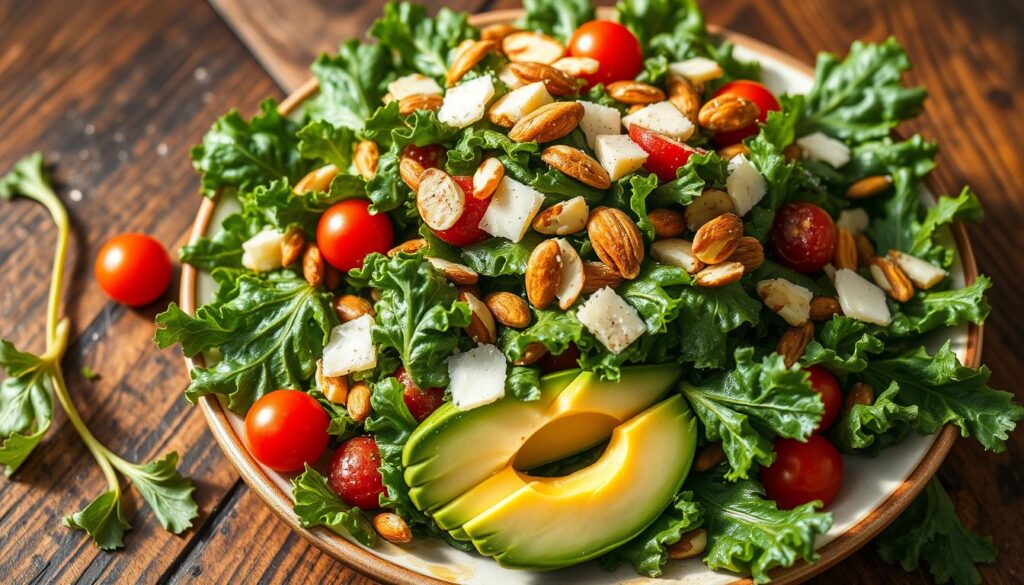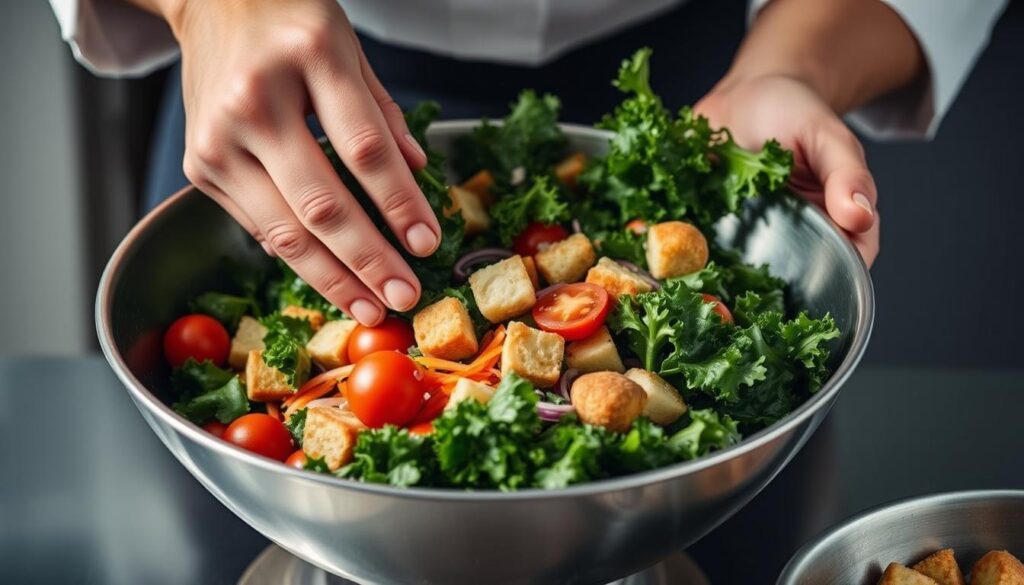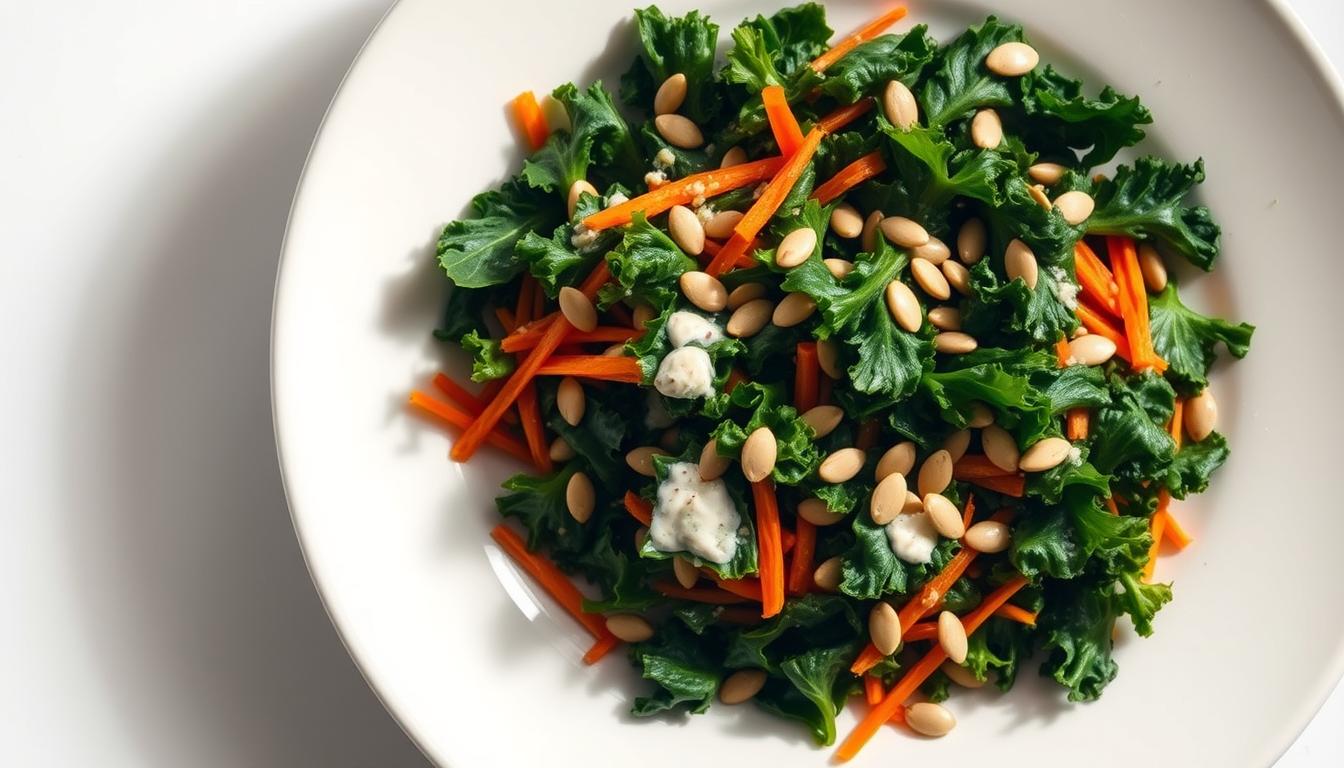Copycat chick fil a kale salad recipe You Can Make at Home
What if you could enjoy your favorite fast-food salad without the additives? Many assume restaurant dishes can’t be replicated at home, but this vibrant mix of crunchy greens and tangy dressing defies expectations. With fresh ingredients and simple steps, you’ll craft a version that’s healthier, cheaper, and tastier than takeout.chick fil a kale salad recipe
The secret lies in balancing textures and flavors. Curly kale and crisp cabbage form the base, while roasted almonds add a nutty crunch. A homemade apple cider maple dressing ties it all together—no preservatives required. Best of all? You’ll spend just 10 minutes prepping this crowd-pleaser.
Why settle for ingredients you can’t pronounce? This guide reveals how to master the dish’s signature taste while controlling what goes into your bowl. Learn why massaging the greens matters and how small tweaks can elevate your results. Ready to rethink fast-food favorites?
Key Takeaways
- Recreate a popular restaurant salad using whole, recognizable ingredients
- Achieve the perfect balance of sweet, tangy, and crunchy textures
- Skip artificial preservatives found in the original version
- Prepare the entire dish in under 15 minutes
- Customize portions and toppings for personal preferences
Introduction to the Copycat Chick-fil-A Kale Salad
Fast food reinvented its image when chains began offering fresh, vegetable-forward dishes that challenge burger stereotypes. One menu standout combines tender greens with a satisfying crunch—a textural contrast that turned drive-thru skeptics into regulars. The original version balances earthy notes with bright acidity, creating a flavor profile that feels both indulgent and nourishing.
What sets this dish apart? It’s not just about tossing leaves in a bowl. The base mixes curly-leaf greens with shredded cabbage for varied mouthfeel. Toasted almonds add depth, while a signature dressing—apple cider vinegar meets maple sweetness—ties everything together. This harmony of elements explains why fans crave it weekly.Make your own Chick-fil-A Kale Salad at home with our easy recipe. Get the exact chick fil a kale salad recipe here.
Restaurant versions often include preservatives to maintain freshness during mass production. By recreating it yourself, you control ingredient quality without sacrificing taste. Many home cooks report their homemade batches stay crisp for days, outperforming takeout containers that wilt within hours.
Nutritionists praise the combination of fiber-rich greens and heart-healthy fats from nuts. Unlike typical fast-food sides loaded with empty calories, this option delivers vitamins A, C, and K in every forkful. It’s proof that convenience meals can align with wellness goals when prepared thoughtfully.
Why Make a Chick-fil-A Kale Salad at Home?
Why settle for mystery ingredients when you can create transparency in every bite? Restaurant versions often contain additives that extend shelf life but compromise nutritional value. By preparing this dish yourself, you remove preservatives like potassium sorbate and synthetic flavors found in commercial preparations.

Control over components means choosing oils you trust. Swap out soybean oil for extra virgin olive oil—a heart-healthy fat packed with antioxidants. This simple switch boosts both flavor and wellness benefits without extra effort.
Your wallet wins too. A single restaurant order costs nearly three times more than homemade portions. With basic pantry staples, you’ll spend less while getting multiple servings. Prep time shrinks to just 10 minutes—quicker than waiting in a drive-thru line.
| Feature | Homemade Version | Restaurant Version |
|---|---|---|
| Key Ingredients | Olive oil, fresh herbs | Soybean oil, additives |
| Cost per Serving | $2.50 | $7.00 |
| Prep Time | 10 minutes | N/A (pre-made) |
| Additives | None | 5+ preservatives |
Customization options let your creativity shine. Add grilled chicken for protein or toss in dried cranberries for sweetness. Adjust dressing ratios to highlight tangy or sweet notes based on your mood.
This approach transforms meal preparation from a chore into an act of self-care. You decide what fuels your body while enjoying flavors that outshine any takeout container.
Gathering Fresh Ingredients for Your Salad
Your dish’s success starts with three essential components: sturdy greens, crisp accents, and flavorful crunch. Quality matters here—each element contributes distinct texture and taste that commercial versions often mask with preservatives.
Leaf Selection and Prep Work
Curly varieties of dark greens outperform others for their structural integrity. Remove fibrous stems by sliding your fingers along each rib—this step prevents chewiness. Chop leaves into palm-sized pieces, then rinse under cold water to eliminate grit.
Pair these greens with thinly shredded light-hued vegetables. A mandoline slicer creates uniform strands that integrate smoothly. Pat everything dry with kitchen towels; moisture dilutes dressings and causes sogginess.
Nutty Textures and Alternatives
Pre-roasted salted nuts deliver immediate flavor, but raw options let you control sodium levels. Toast raw varieties in a dry skillet for 4 minutes until fragrant. Cool completely before adding to prevent wilting.
| Nut/Seed Option | Flavor Profile | Prep Time |
|---|---|---|
| Roasted Almonds | Savory, salty | 0 minutes |
| Raw Almonds | Mild, earthy | 5 minutes |
| Sunflower Seeds | Nutty, subtle | 0 minutes |
| Pepitas | Earthy, crunchy | 3 minutes |
For dietary restrictions, try shelled hemp hearts or crushed walnuts. These swaps maintain the necessary contrast while accommodating preferences.
Crafting the Apple Cider Maple Vinaigrette
The dressing transforms ordinary greens into something extraordinary. Unlike store-bought versions, this emulsion lets you control sweetness and acidity while delivering fresh flavors that cling to every leaf. Perfect your ratio once, and you’ll never crave bottled alternatives again.
Mixing Extra Virgin Olive Oil and Apple Cider Vinegar
Start with ½ cup of cold-pressed olive oil—its peppery notes enhance the dressing’s complexity. Combine it with ¼ cup of raw apple cider vinegar in a mason jar. The sharp tang softens when shaken with oil, creating a balanced base that doesn’t overpower delicate greens.
Balancing Dijon Mustard and Maple Syrup
Add 1 tablespoon of grainy Dijon to the jar. This ingredient works double duty: it adds depth while binding oil and vinegar. Drizzle in 2 tablespoons of pure maple syrup, then shake vigorously for 20 seconds. Taste and adjust—add more syrup for sweetness or lemon juice for brightness.
| Ingredient | Sweet Profile | Tangy Profile | Neutral |
|---|---|---|---|
| Maple Syrup | 3 tbsp | 1 tbsp | – |
| Apple Cider Vinegar | 2 tbsp | 4 tbsp | – |
| Dijon Mustard | – | – | 1.5 tbsp |
Store leftovers in the fridge up to 5 days. The flavors intensify over time—shake well before each use. For thicker consistency, let it sit at room temperature 10 minutes before serving.
Step-by-Step Instructions for Your Salad
The key to perfect texture lies in a surprising manual process. Forget complicated tools—your hands become the ultimate kitchen gadget here. This method ensures every leaf gets coated evenly while transforming the greens’ structure.
Preparing and Massaging the Greens
Remove stems by sliding your thumb along each rib. Chop leaves into bite-sized pieces and rinse thoroughly. Spin dry or pat with towels—moisture repels dressing. Place greens in a large bowl and drizzle with half the vinaigrette.
Massage firmly for 2-3 minutes. Watch leaves darken and soften as fibers break down. This step unlocks natural sweetness while helping the mixture cling to every fold.
Combining Crunch and Flavor
Add shredded light-colored vegetables to the bowl. Toss gently to preserve their crispness. Pour remaining dressing over the mix, using tongs to distribute it evenly.
Let flavors meld for 5 minutes before serving. Sprinkle roasted nuts on top—their crunch stays intact when added last. For best results, assemble just before eating.
| Prep Stage | Time Needed | Key Benefit |
|---|---|---|
| Stem Removal | 3 minutes | Eliminates chewiness |
| Massaging | 2 minutes | Enhances tenderness |
| Resting | 5 minutes | Boosts flavor absorption |
Mastering the chick fil a kale salad recipe

Perfecting this dish begins with your fingertips. When working with sturdy greens, massaging breaks down cellulose fibers that create chewiness. Drizzle half the dressing over rinsed leaves, then knead gently for 90 seconds. You’ll feel the texture soften as the leaves darken—a clear sign they’re ready to absorb flavors.
Timing matters more than you think. Add nuts and crisp vegetables just before serving to maintain their signature snap. Let dressed greens rest 5 minutes while prepping other components. This pause allows flavors to marry without sacrificing texture.
Balance sweet and tangy elements by tasting as you mix. If bitterness dominates, add ½ teaspoon honey to the dressing. For extra crunch, toast nuts twice—first dry, then lightly coated in leftover dressing. The double heat treatment creates an irresistible caramelized coating.
Efficiency comes with practice. After three attempts, most cooks complete the entire process in 8-10 minutes. Store prepped ingredients separately for quick assembly—dress greens only when ready to eat. Your efforts yield a lunch option that stays crisp for hours, unlike soggy takeout versions.
Variations and Customizations to Suit Your Taste
Your bowl becomes a canvas for culinary creativity. Swap almonds for roasted sunflower seeds to introduce earthy notes. Try toasted pepitas for extra crunch without overpowering other flavors.
Dairy lovers can crumble feta or shave parmesan over the greens. For vegan options, nutritional yeast mimics cheese richness while keeping it plant-based. Adjust dressing quantities to highlight sweet or tangy preferences.
Stretch the recipe further by adding protein-packed chickpeas or grilled shrimp. Mix in dried cranberries for bursts of sweetness that balance bitter greens. Leftovers stay fresh 3 days when stored undressed.
Gluten-free? Replace croutons with crushed rice crackers. Nut allergies? Use roasted seeds instead. This adaptable dish grows with your tastes—no two versions need ever match.






